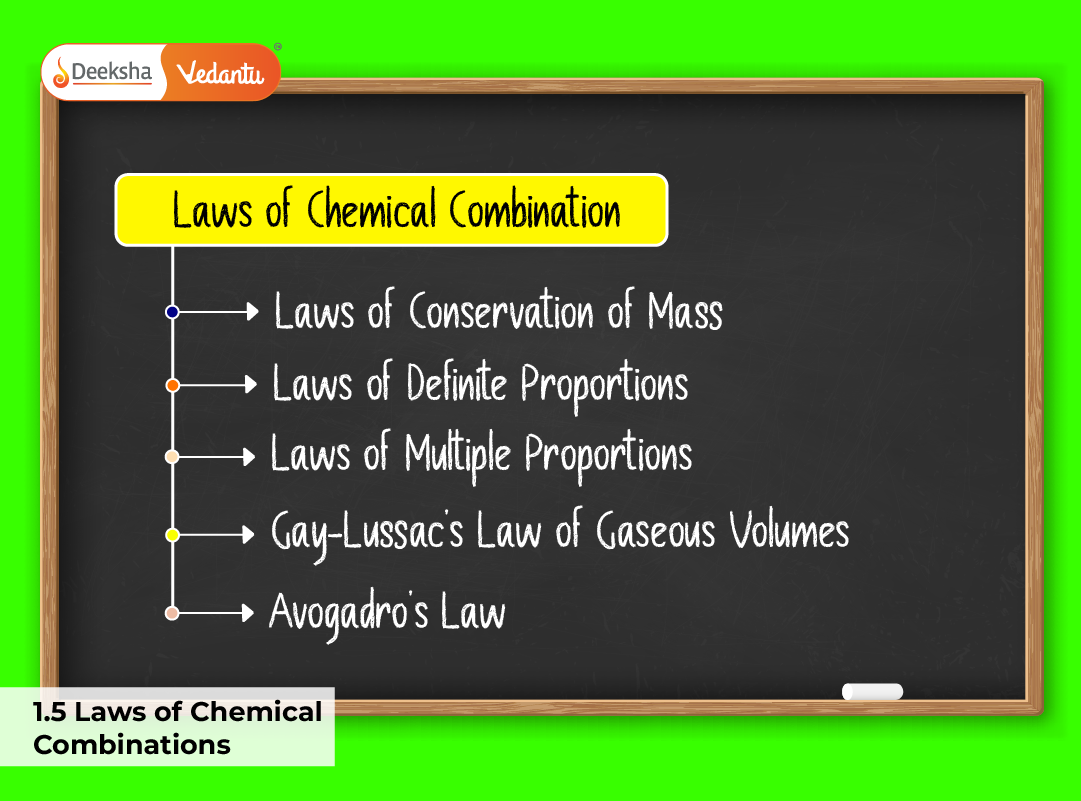
Chemistry as a science is built upon measurable and verifiable relationships between substances. The Laws of Chemical Combination are the fundamental building blocks that connect experimental chemistry with theoretical atomic concepts. These laws describe how elements combine in definite ratios and reveal that chemical reactions are governed by certain fixed mathematical relationships. Understanding these principles is not only essential for academic excellence but also critical for competitive exams like JEE Main and JEE Advanced.
During the 18th and 19th centuries, scientists such as Lavoisier, Proust, Dalton, and Avogadro conducted pioneering experiments that transformed chemistry from a qualitative to a quantitative science. Their observations helped develop these foundational laws:
- Law of Conservation of Mass
- Law of Definite Proportions
- Law of Multiple Proportions
- Gay Lussac’s Law of Gaseous Volumes
- Avogadro’s Law
Each law plays a unique role in explaining the stoichiometry of chemical reactions and the fixed relationships among reactants and products.
Law of Conservation of Mass
Statement:
Matter can neither be created nor destroyed during a chemical reaction. The total mass of substances before and after the reaction remains constant.
Mathematical Representation:
Total mass of reactants = Total mass of products.
This means that if 10 grams of hydrogen react with 80 grams of oxygen, the total product (water vapor) will weigh 90 grams, assuming the reaction is complete and conducted in a closed system.
Example:
2H₂ + O₂ → 2H₂O
Here, mass of hydrogen (4 g) + mass of oxygen (32 g) = 36 g of water vapor produced.
Explanation:
Every atom present in the reactants is accounted for in the products. Atoms rearrange to form new compounds but are never created or destroyed. This forms the basis of balancing chemical equations.
Historical Insight:
Antoine Lavoisier, regarded as the father of modern chemistry, performed combustion experiments in sealed containers. He noted that although substances changed form, the overall mass of the system did not change.
JEE Connection:
Questions often ask for mass calculations or balancing equations based on this law. For example, if 2.5 g of copper reacts with oxygen to form 3.13 g of copper oxide, the oxygen mass can be determined by simple subtraction: 3.13 – 2.5 = 0.63 g.
Law of Definite Proportions
Statement:
A chemical compound always contains the same elements combined together in the same fixed proportion by mass, regardless of its source or method of preparation.
Illustration:
Water (H₂O) always contains hydrogen and oxygen in a mass ratio of 1:8, whether it comes from a river, rain, or is synthesized in a laboratory.
Mathematical Expression:
Mass ratio = (Mass of one element) / (Mass of the other element) = Constant.
Explanation:
This implies that elements combine in definite atomic ratios. Since the atomic weights are constant, the proportion by mass remains unchanged.
Example:
Carbon dioxide (CO₂) → Carbon (12 parts) : Oxygen (32 parts) = 3:8.
Example:
If a sample of water from one source contains 2 g of hydrogen and 16 g of oxygen, another sample with 4 g of hydrogen will necessarily have 32 g of oxygen.
Importance in Chemistry:
This law supports Dalton’s Atomic Theory, which proposes that atoms of different elements combine in simple whole-number ratios.
JEE-Oriented Example:
Calculate the percentage composition of hydrogen and oxygen in water.
H₂O = (2 × 1) + 16 = 18 g/mol.
% Hydrogen = (2/18) × 100 = 11.11%; % Oxygen = (16/18) × 100 = 88.89%.
Law of Multiple Proportions
Statement:
When two elements combine to form more than one compound, the different masses of one element that combine with a fixed mass of the other element are in small whole-number ratios.
Example:
Carbon and oxygen combine to form two compounds:
- Carbon monoxide (CO) → 12 g C + 16 g O.
- Carbon dioxide (CO₂) → 12 g C + 32 g O.
Mass ratio of oxygen = 16:32 = 1:2 (a simple whole number ratio).
Interpretation:
This law demonstrates that elements combine in discrete atomic units, further supporting Dalton’s Atomic Theory.
Example:
Nitrogen and oxygen form multiple oxides (NO, NO₂, N₂O₃, N₂O₅). If we fix nitrogen at 14 g, the oxygen masses are in the ratio 8:16:24:40 = 1:2:3:5 — all small whole numbers.
JEE Connection:
Frequently used in empirical formula and molecular mass determination problems. Students may be asked to compare data and derive ratios between compounds.
Gay Lussac’s Law of Gaseous Volumes
Statement:
When gases react together to form gaseous products, their volumes are in simple whole-number ratios when measured under identical temperature and pressure conditions.
Mathematical Relation:
Volume ratio = Simple whole-number ratio between reactants and products.
Example:
Hydrogen + Oxygen → Water vapor
2 volumes of H₂ + 1 volume of O₂ → 2 volumes of H₂O.
Observation:
The ratio 2:1:2 represents the simple combining volumes.
Further Example:
Ammonia formation: N₂ + 3H₂ → 2NH₃.
Here, the volume ratio is 1:3:2.
Significance:
This law suggests that gases combine in fixed ratios by volume, hinting at the molecular nature of matter.
Experiment and Historical Note:
Proposed by Joseph Louis Gay-Lussac in 1808, who observed simple volume ratios during reactions involving gaseous substances such as hydrogen chloride and ammonia.
JEE Application:
Used in solving gas law problems and stoichiometry where gas volumes can directly replace mole ratios.
Avogadro’s Law
Statement:
Equal volumes of all gases under the same conditions of temperature and pressure contain the same number of molecules.
Mathematical Expression:
V ∝ n (at constant T and P)
Or V₁/V₂ = n₁/n₂.
Implication:
If temperature and pressure remain constant, doubling the number of moles doubles the volume.
Example:
At STP, 22.4 L of hydrogen, oxygen, nitrogen, or carbon dioxide each contain 6.022 × 10²³ molecules.
Applications:
- Establishes the relation between gas volume and number of moles.
- Derives molar volume at STP (22.4 L/mol).
- Determines molecular formulas and atomic masses.
- Explains gaseous reaction ratios observed in Gay Lussac’s law.
JEE Example:
Determine the number of molecules in 44.8 L of CO₂ at STP:
Moles = 44.8/22.4 = 2; Molecules = 2 × 6.022 × 10²³ = 1.204 × 10²⁴.
JEE-Oriented Insights
Weightage:
2–3 marks in JEE Main and 3–4 marks in JEE Advanced.Typical Question Types:
- Mass ratio and stoichiometry problems.
- Empirical vs molecular formula determination.
- Gas volume calculations using Avogadro’s or Gay Lussac’s laws.
- Conceptual theory-based multiple-choice questions.
Preparation Tips:
- Memorize molecular and molar volumes.
- Keep conversions between liters, moles, and grams at your fingertips.
- Revise atomic masses and standard gas equations regularly.
FAQs
Q1. Who discovered the Law of Conservation of Mass?
Antoine Lavoisier discovered it in 1774 through experiments proving that mass remains constant before and after chemical reactions.
Q2. What differentiates the Law of Definite and Multiple Proportions?
The Law of Definite Proportions focuses on one compound’s fixed ratio, while the Law of Multiple Proportions compares ratios across multiple compounds formed from the same elements.
Q3. How does Avogadro’s Law explain Gay Lussac’s Law?
Avogadro’s Law provides molecular reasoning: gases with equal volumes at the same conditions contain equal molecules, supporting Gay Lussac’s observed simple ratios.
Q4. Why is the Law of Conservation of Mass essential for balancing equations?
It ensures the number of atoms of each element is equal on both sides of an equation, maintaining mass consistency.
Q5. What is the real-world significance of these laws?
They are applied in chemical industries, pharmaceuticals, and analytical chemistry for predicting yields, purity, and reaction efficiency.
Q6. How often are these laws tested in JEE exams?
Almost every year, either directly or indirectly through stoichiometric, gas law, or molecular formula problems.
Q7. Can Avogadro’s Law be applied to solids or liquids?
No, it applies only to gases where molecular motion is free and measurable.
Conclusion
The Laws of Chemical Combination are the cornerstones of classical chemistry and the basis for modern atomic theory. They reveal that chemical changes occur in a quantitative and predictable manner, governed by atomic ratios and conservation principles. For JEE aspirants, mastering these concepts lays a strong foundation for advanced topics like chemical bonding, gas laws, and stoichiometry. By understanding these relationships and practicing numerical applications, students can efficiently solve both conceptual and computational problems in competitive exams and laboratory studies.






Get Social